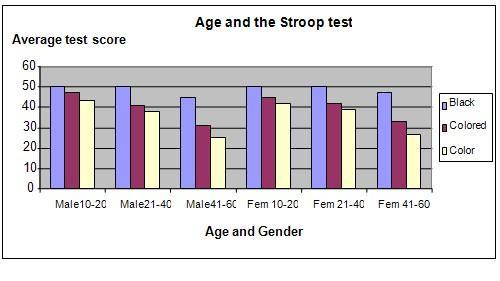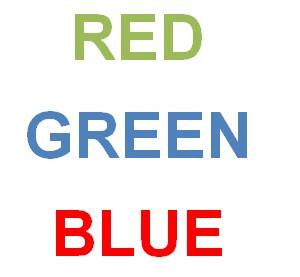| Complexity level: | 8 |
| Project cost ($): | 30 |
| Time required: | 2 hours to prepare, 2 hours for the science project experiment |
| Material availability: | Easily found |
| Safety concerns: | Basic safety requirements |
Hypothesis
Older test subjects perform more poorly at the Stroop test.
Overview
Stroop effect
The Stroop effect is a test to demonstrate how our brain manages and process conflicting information. It also enables us to evaluate the reaction time taken required understand and complete the conflicting task. Although the Stroop effect was originally discovered in Germany in 1929, the English publication by John Ridley Stroop describing it, was only released in 1935.
Different parts of the brain are responsible for processing different types of tasks. When a person is shown a word written in “BLUE”, but the color of the text is red, one part of the brain will be interpreting the written text. At the same time, another part of the brain will be processing the fact that the text is red in color. This conflicting information causes a delay in the time required by the brain to process the information.
To complete the above task, one part of the brain has to dominate, and at the same time inhibit the response of other parts of the brain. This is called interference and normally the part of brain that handles reading abilities, will dominate.
Scientific Terms
Materials
The materials required for this science fair project:
- 10 male and 10 female participants aged 10 to 20
- 10 male and 10 female participants aged 21 to 40
- 10 male and 10 female participants aged 41 to 60
- 2 cards with 50 colors randomly written in black
- 2 cards with 50 colors randomly written where the color of the text must be different from the color represented by the written word.
- A stop watch
- An assistant
Procedure
1. For this science fair project, the independent variable is the age of the participants. The dependent variable is the number of correct words read in 30 seconds. This is determined by checking the words as they are read and recording the time with a stop watch. The constants (control variables) are the number of words, the size of the font, the color of the background and the time allotted to read the text.
2. The 60 participants are divided into 3 age groups of 10 to 20, 21 to 40 and 41 to 60 years. Each age group will consist of 10 boys and 10 girls.
3. Each participant will be given 3 tests as described below.
a. For the first test, the participants will be shown the cards with 50 colors written in black. They are given 30 seconds to read the 50 words. The number of correct words read in 30 seconds will be recorded.
b. For the second test, the participants will be shown the cards with 50 colors randomly chose, where the printed color of the text on each card is different from the color described. The participants are given 30 seconds to read the 50 words and the number of words read correctly will be recorded.
c. For the third test, the participants are required to announce out loud the color of the text and not the word. They are given 30 seconds to do this for all 50 words and the number of correctly announced colors is recorded.
4. The 3 tests described in procedure 3 will be performed on all 60 participants. The score of each participant in their age and gender group will be totaled and divided by 10 to obtain the average score. The average results are recorded in the table given below.

Results
The younger participant’s average scores were higher than the older participants’ average score in all the 3 tests conducted.
|
Male Stroop test average score |
Female Stroop test average score |
|||||
|
Male 10-20 |
Male 21-40 |
Male 41-60 |
Female 10-20 |
Female21-40 |
Female 41-60 |
|
|
Black text |
50 |
50 |
45 |
50 |
50 |
47 |
|
Colored text |
47 |
41 |
31 |
45 |
42 |
33 |
|
Color of text |
43 |
38 |
25 |
42 |
39 |
27 |
The chart below represents the results of our science project experiment.

Conclusion
Our hypothesis has been proven to be correct - older test subjects perform more poorly at the Stroop test.
The Stroop effect is normally used to test a person’s neuropsychological abilities. It can help in evaluating mental processing speeds, their cognitive abilities and selective attention. People with brain damage, dementia or other types of mental illness have been found to be subject to higher interference within their brains.
Also consider
To improve the reliability and accuracy of our results, a larger sample of participants should be used.
This science fair project may be repeated, this time, to test if the font size will influence the results of the Stroop effect.
Modify the science project experiment, repeating the test on papers with different colored backgrounds.
References
Stroop effect - http://en.wikipedia.org/wiki/Stroop_effect
Stroop effect - http://hypnosisschool.org/hypnotic/stroop-effect.php

